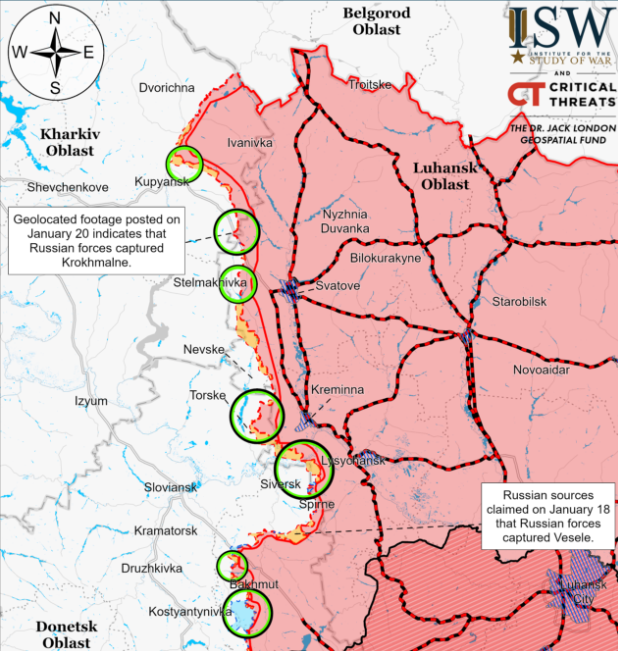ISW also reported that Russian forces recently advanced along the Kupiansk-Svatove-Kreminna line on 20 January, ISW said in its daily report on 21 January.
According to the Institute for the Study of War, Russian forces captured Krokhmalne, 20 km northwest of Svatove, Kharkiv Oblast.
Volodymyr Fitio, the Land Forces Command spokesman, confirmed on 21 January that Krokhmalne village is currently under Russian control. According to Fitio, Ukrainian troops have withdrawn from their positions in Krokhmalne village in the Kupiansk sector to more prepared positions.
The village of Krokhmalne was occupied for the second time. In 2022, it was liberated during the Slobozhansk counteroffensive.
ISW also said in its daily report that Russian forces marginally advanced east of Ivanivka, 20km southeast of Kupiansk.
The Russian military recently advanced southwest of Bakhmut, ISW reported. Geolocated footage posted on 20 January shows Russian forces recently advanced in a small forest belt northwest of Klishchiivka (southwest of Bakhmut).
ISW also reports that Russian troops have made minor advances near the border of Donetsk and Zaporizhzhia oblasts. Geolocation footage released on 20 January shows limited Russian advances southeast of Urozhaine (10 km south of Velyka Novosilka).
Other takeaways from the ISW report:
- Russian President Vladimir Putin falsely claimed that Russia supports the “unconditional equality” and “sovereignty” of all states in a 20 January letter to the Non-Aligned Movement Summit, contradicting Russia’s official position on its war in Ukraine and its wider imperial ambitions.
- Russian Ambassador to Denmark Vladimir Barbin threatened Denmark, a founding member of NATO, on 20 January in response to a recent US-Danish agreement allowing US forces access to military bases in Denmark.
- Russian energy exports to China significantly increased in 2023 amid increasing Russian reliance on oil revenues to manage the fiscal burdens of the war in Ukraine.
- European Union (EU) Internal Market Commissioner Thierry Breton stated on 20 January that the EU will have the capacity to produce 1.3 to 1.4 million artillery shells by the end of 2024 and will ensure that it delivers the “majority” of the shells to Ukraine.
Read also:
- Russia shelled Donetsk Oblast 11 times over the past day, injuring 2 people
- Russia reports downing 4 drones over Smolensk Oblast
- Ukraine’s police identify five suspects in harassment of investigative journalist







